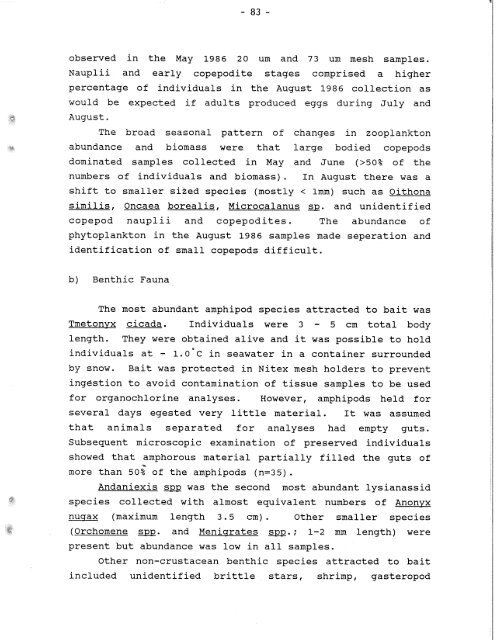Distribution of Chlorinated Hydrocarbon Pesticides and PCBs in the ...
Distribution of Chlorinated Hydrocarbon Pesticides and PCBs in the ...
Distribution of Chlorinated Hydrocarbon Pesticides and PCBs in the ...
You also want an ePaper? Increase the reach of your titles
YUMPU automatically turns print PDFs into web optimized ePapers that Google loves.
observed <strong>in</strong> <strong>the</strong> Play 1986 20 um <strong>and</strong> 73 um mesh samples.<br />
Nauplii <strong>and</strong> early copepodite stages comprised a higher<br />
percentage <strong>of</strong> <strong>in</strong>dividuals <strong>in</strong> <strong>the</strong> August 1986 collection as<br />
would be expected if adults produced eggs dur<strong>in</strong>g July <strong>and</strong><br />
August.<br />
The broad seasonal pattern <strong>of</strong> changes <strong>in</strong> zooplankton<br />
abundance <strong>and</strong> biomass were that large bodied copepods<br />
dom<strong>in</strong>ated samples collected <strong>in</strong> May <strong>and</strong> June (>50% <strong>of</strong> <strong>the</strong><br />
numbers <strong>of</strong> <strong>in</strong>dividuals <strong>and</strong> biomass). In August <strong>the</strong>re was a<br />
shift to smaller sized species (mostly < %m) such as Oithona<br />
similis, Oncaea borealis, Microcalanus sp. <strong>and</strong> unidentified<br />
copepod nauplii <strong>and</strong> copepodites. The abundance <strong>of</strong><br />
phytoplankton <strong>in</strong> <strong>the</strong> August 1986 samples made seperation <strong>and</strong><br />
identification <strong>of</strong> small copepods difficult.<br />
b) Benthic Fauna<br />
The most abundant amphipod species attracted to bait was<br />
Tmetonyx cicada. ~ndividuals were 3 - 5 cm total body<br />
length. They were obta<strong>in</strong>ed alive <strong>and</strong> it was possible to hold<br />
<strong>in</strong>dividuals at - 1. OoC <strong>in</strong> seawater <strong>in</strong> a conta<strong>in</strong>er surrounded<br />
by snow, Bait was protected <strong>in</strong> Nitex mesh holders to prevent<br />
<strong>in</strong>gestion to avoid contam<strong>in</strong>ation <strong>of</strong> tissue samples to be used<br />
for organochlor<strong>in</strong>e analyses. However, amphipods held for<br />
several days egested very little material. It was assumed<br />
that animals separated for analyses had empty guts.<br />
Subsequent microscopic exam<strong>in</strong>ation preserved <strong>in</strong>dividuals<br />
showed that amphorous material partially filled <strong>the</strong> guts <strong>of</strong><br />
"%i<br />
more than 50% <strong>of</strong> <strong>the</strong> amphipods (n=35).<br />
Andaniexis m was <strong>the</strong> second most abundant lysianassid<br />
species collected with almost equivalent numbers <strong>of</strong> Anonyx<br />
nusax (maximum length 3.5 em). O<strong>the</strong>r smaller species<br />
(Orchomene m. <strong>and</strong> Menisrates m.; 1-2 mm length) were<br />
present but abundance was low <strong>in</strong> all samples.<br />
O<strong>the</strong>r non-crustacean benthic species attracted to bait<br />
<strong>in</strong>cluded unidentified brittle stars, shrimp, gasteropod

















